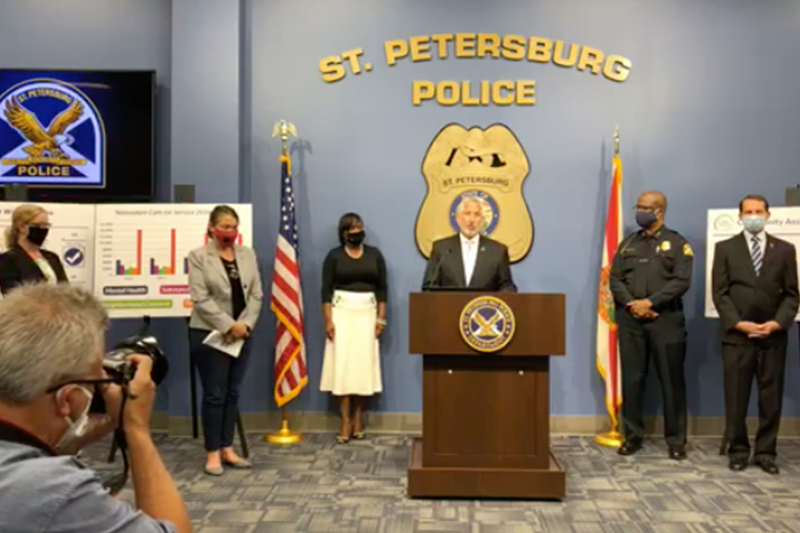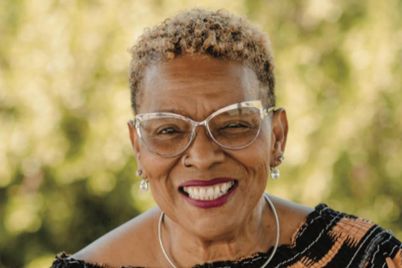On July 10, Mayor Rick Kriseman and Police Chief Anthony Holloway announced changes to the response of certain 911 calls.
BY FRANK DROUZAS, Staff Writer
ST. PETERSBURG — Amid outcries for police reform across the country, the St. Petersburg Police Department is about to change its response to calls.
Speaking from the police headquarters on July 10, Mayor Rick Kriseman said that money the city planned to allocate to the SPPD to hire more officers will now go toward establishing a response team consisting of community and social services professionals.
“We are open to change,” the mayor said.
Police Chief Anthony Holloway noted that since the death of George Floyd — an African American killed by a white police officer on May 25 in Minneapolis — and the ensuing protests, the SPPD has talked to faith leaders, community groups and other organizations about modifications citizens want to see in law enforcement.
Holloway pointed out that the SPPD already adhered to all the policies in the “8 Can’t Wait” reform initiative designed to reduce police killings, which includes:
- banning chokeholds
- requiring de-escalation
- requiring warning before shooting
- seeking all alternatives before shooting
- requiring a duty to intervene
- banning shooting at moving vehicles
- requiring the use of force continuum
- requiring the use of comprehensive reporting
The only modification the department made was to write the word “intervene” in its policy officially.
The department had received a grant to hire 25 new officers but decided instead to use the $3.1 million federal grant (plus a $3.8 million city match) to develop a new team called Community Assistance Liaison, or CAL. Holloway said the department scrutinized the sorts of calls the police have to answer, including non-violent ones. Though members of the police force may have some training in dealing with people with mental issues or truant children, for example, the officers are not professionals in that field, he said.
That is the aim of CAL — to respond to calls and assist people in need that do not require an immediate police presence. In the case of a truant child, a member of the CAL division may follow up.
“So if that child doesn’t want to go to school,” Holloway explained, “instead of sending an officer there, we’ll send this person there to help that parent to negotiate how to get that child back into school, and how can they help that child.”
CAL members might also be dispatched to deal with people who are suicidal, intoxicated or arguing with a neighbor. Unlike police officers, these social workers will wear no uniform and will not be armed.
This initiative is slated to take effect Oct. 1 and will be housed within the police department. Assistant Police Chief Antonio Gilliam will oversee it while Megan McGee will be the division’s coordinator. The CAL members will be operating from 6 a.m. until 2 a.m., and there will be three members working within each district to handle calls to service.
There are more changes the department plans to make. Self-defense training will be increased from once a year to twice a year, as well as de-escalation training.
“And if possible, every other month, the squad will go to the training facility because we have a simulator there so we can teach officers how to bring someone down,” the chief said. “How to deescalate someone during their crisis.”
Over a year and a half ago, new recruits spent four hours with Rev. Kenneth Irby, director of Community Intervention and Juvenile Outreach for the SPPD, but it will now be an eight-hour course. The department will ask officers who have been out on the beat for one year what they have learned in that year and how they can make things better.
Training methods aren’t the only things that will be revised, as Holloway said the department would evaluate all police equipment.
“I mean from body cameras all the way down to our gun belts,” he said. “We’re going to look at everything we have.”
The SPPD will also conduct a thorough policy review to identify any changes it can make for the better concerning the use of force and how police complaints are handled. Also, starting Oct. 1, the department will have a representative from the community to sit on the hiring board. Holloway said it could be someone from the NAACP, Urban League, Leadership St. Pete, the faith community, or anyone who wants to fill out an application and can pass the background check.
By having CAL members respond to non-violent calls, officers will devote an extra hour or two a week to the Park, Walk and Talk program, where officers spend time walking through their communities and holding discussions with citizens.
The department will also change how it monitors calls for service.
“Believe it or not, we still get some calls about, ‘There’s an African-American male sitting in the park, he doesn’t look like us.’ We’re not coming to those calls,” Holloway stated. “If that person, he or she, is not committing a crime, we’re not going to that.”
Union president Jonathan Vazquez said he fully supports this plan created throughout weeks of discussion between the police department and the Sun Coast Police Benevolent Association. He pointed out that officers must daily respond to calls for social issues such as homelessness, family discord, truancy, juvenile behavioral issues, substance abuse and mental abuse crises.
“Every police officer, community leader, and citizen I’ve spoken to agrees it’s time for law enforcement to refocus on crime reduction and neighborhood safety,” he said. “It is time to allow the experts in the field of social services more opportunities for direct involvement in these incidents.”
Kriseman said that St. Pete has no fight with peaceful protesters, stressing that they have helped “to shine a light on injustice and inequity in America.” The mayor added that when protesters gathered outside the St. Pete Police Department, he took a knee with them in a show of solidarity.
“Innovation is a part of our vision statement here in St. Pete,” the mayor said. “And while this is not a police department with a bloated budget or one with frivolous toys, it is a department that can continue to get even better.”








